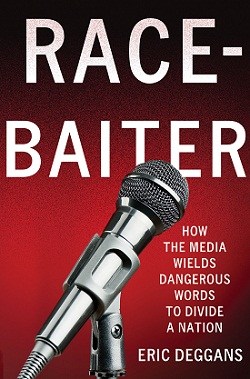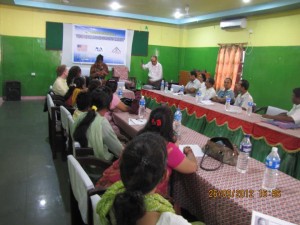As I write this, the United States is re-enacting the second inauguration of Pres. Barack Obama and Vice President Joe Biden. In a nod to the Civil Rights Movement that did so much to make an African-American possible, Myrlie Evers-Williams will give the invocation. Her first husband, Medgar Evers, was martyred nearly 50 years ago for registering black people to vote in Mississippi. Evers was a colleague and of Dr. Martin Luther King, Jr., whose birthday is being marked today as a national holiday.
Tomorrow, I begin teaching the latest version of my Race, Gender and News class, which is cross-listed between TCNJ’s journalism/professional writing major and our African-American Studies minor. At this moment, I happen to chair the African-American Studies Department while teaching in journalism and interactive multimedia. I watch this moment as a child and student of the Civil Rights movement, an American, a journalist and educator committed to building structures for peaceful change through civic dialog. My friend and college classmate, legal scholar Adrien Wing, articulated the challenge of synthesizing and acting upon through the prism of these multiple perspectives in her insightful and poignant 1990 essay for the Berkeley Women’s Law Journal, “Brief Reflections Toward a Multiplicative Theory and Praxis of Being.”
As Wing says, ” [F]eeling is first,” so I’ll begin there. The President is a man of my generation, with a personal narrative that bears some similarities with my own. His wife is one degree of separation from me, many times over, because we share the same undergraduate alma mater. I knew her brother there, as well one of their closest friends and supporters. As an undergraduate, I knew Justice Sonia Sotomayor, who administered the oath to VP Biden. I have grown more used to seeing these friends of my youth on the national stage in the last four years, but part of me is still awestruck. Their ascendance represent impossibilities that became possible in my lifetime.
And yet, they also represent something else that we Civil RIghts children used to repeat to each other during our undergraduate years — that human progress does not come through the actions of charismatic leaders, but through the concerted efforts of many people over time, most of whom will only be known to those who loved them. Feeling and inspiration have their place, but clear-eyed assessments are what matters.
Both the power and limits of charisma, smarts and inspiring personal narrative have been evident during the Obama years, and have been the focus of contentious and sometimes mean-spirited debate. Whether one loved or loathed Pres. Obama in January, 2009, he has defied easy categorization. The president who extended an open hand to Iran also gave the order for the drones that regularly strafe outposts in Yemen and Pakistan thought to harbor terrorists. Those up in arms about his recent executive orders on guns might do well to remember that one of his first acts after his 2009 inauguration was to order the closure of the notorious prison at Guantanamo Bay. That hasn’t happened, although administration officials reportedly say they will keep trying. According to Politifact, Obama kept about half of his campaign promises during this first term, compromised on another 20 percent, and broke about 25 percent.
Some of this, of course, is the reality of ordinary politics. No president fulfills all of his promises. And perhaps it is predictable that a president who prepared for his first term by studying Lincoln and FDR would, like them, endure accusations that he was overstepping his bounds and trampling on liberty. But race is inevitably part of the equation. Ta-Nehesi Coates and William Jelani Cobb have provocatively written on this; I need say little more here than to urge a reading of their words for those who haven’t. But I will note this – students of the Civil Rights movement note with concern the fact that, as Dr. King once said of Alabama’s pro-segregationist governor, the lips of some gun-rights advocates and Obamacare opponents are, “dripping with words of interposition and nullification.” Nor have they lost sight of the pro-segregation lineage of some Obama opponents, such as the Council of Conservative Citizens.
 We’ll be using Eric Deggan’s new book Race Baiter: How the Media Uses Dangerous Words to Divide a Nation as one of core texts. As Deggans puts it:
We’ll be using Eric Deggan’s new book Race Baiter: How the Media Uses Dangerous Words to Divide a Nation as one of core texts. As Deggans puts it:
“This book is an attempt to decode the ways media outlets profit by segmenting Americans. I call it the Tyranny of the Broad Niche; what happens as the biggest pieces of an increasingly fragmented audience are courted at the expense of many others.”
In communities such as Mercer County, New Jersey, where our journalism undergraduates and alumni play a critical role in news coverage, progress during the Obama administration’s second term will likely be gauged by personal measures of well-being: whether the capital city of Trenton’s long economic decline can be stemmed, whether the states’ above-average unemployment rate can be reversed, whether something can be done about the almost-daily deadly shootings and abysmal graduation rates. While much of the Trenton news media’s focus in 2013 will likely be consumed with the pending corruption prosecutions of Mayor Tony Mack, et. al. and the latest sound-byte from the blustering, contrarian Governor Chris Christie, I’ll strive to keep my students focused on the processes and dynamics that affect people’s lives but don’t readily lend themselves to twitpic or SEO-optimised clickbait accompanied by top-dollar contextual ads.
The world is watching, and not just in obvious places, such as London, Jerusalem, Nairobi or Caracas. This past September, I was privileged to spend a week in Nepal at the behest of the US State Department, where I participated in conversations with students, human rights advocates, legal experts, journalists, educators and government officials about building democracy through a strong and inclusive civil society. Many of our conversations were about the applicability of the US Civil Rights and feminist movements to Nepal’s very challenging and complex political situation, and I was asked more than once to opine on the role of racism in the opposition to Obama. As the International Crisis Group notes, Nepal is at an impasse in its efforts to adopt a new Constitution largely because, “Nepali actors are deeply divided on the role of identity politics in the proposed federal set-up.” In the face of these divisions, activists groups such as Fichar Nepal wage a valiant campaign for peaceful and inclusive change.
spend a week in Nepal at the behest of the US State Department, where I participated in conversations with students, human rights advocates, legal experts, journalists, educators and government officials about building democracy through a strong and inclusive civil society. Many of our conversations were about the applicability of the US Civil Rights and feminist movements to Nepal’s very challenging and complex political situation, and I was asked more than once to opine on the role of racism in the opposition to Obama. As the International Crisis Group notes, Nepal is at an impasse in its efforts to adopt a new Constitution largely because, “Nepali actors are deeply divided on the role of identity politics in the proposed federal set-up.” In the face of these divisions, activists groups such as Fichar Nepal wage a valiant campaign for peaceful and inclusive change.

As a journalist and educator, my job is to seek and encourage that broader, richer understanding of moments such as these. That’s akin to asking a chef to deliver a multi-course banquet to diners conditioned to the microwaved info-snacks continuously served up by cable news and its social media extensions. I plan to try some new things in the classroom and with class projects to encourage healthier news production and consumption; we’ll see how it goes.
In the meantime, here are a two story angles that I do find interesting in relation to today’s events that probably won’t get much press attention:
- Robert Moses’ birthday. The key architect of Freedom Summer and founder of the Algebra Project turns 78 on January 23. It’s a perfect occasion to finally focus attention on what 30 years of research and civic action around math education can teach us, as well as his contention that making quality education a constitutional right is the logical extension of the Civil Rights movement today.
- The impact of Michelle Obama’s healthy-eating initiatives. According to a recent Washington Post article, feminists are “divided” over Obama’s characterization of herself as “Mom-in-chief,” and find her focus on childhood obesity “trivial,” especially compared to former First Lady Hillary Clinton’s prominent role in her husband’s administration. (As is too often the case with such political stories, the story appeared in the Style section, with and referred to her ‘work’ in literal quotation marks.) One might have hoped for some investigation of the actual impact of her Let’s Move initiative, given the importance of childhood obesity as a public health issue, and the considerable effort being expended by advocates, non-profits and local governments to improve healthy food access. In fact, I’ve only seen one such investigation: an October, 2012 article by Bridget Huber of the Food and Environment Reporting Network judging the results of her strategy of forging public-private partnerships to be modest and controversial among activists. More local follow-up on this matter would be welcome, especially pared with analyses of the impact of the Administration’s 2010 $400 million Healthy Food Financing Initiative.
And so we all begin again.